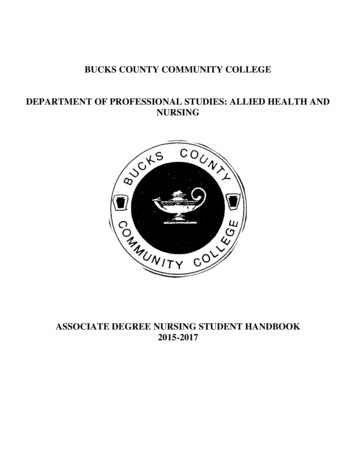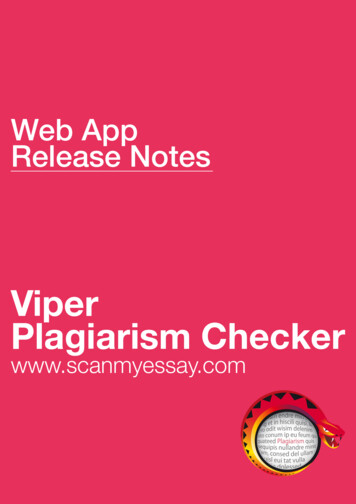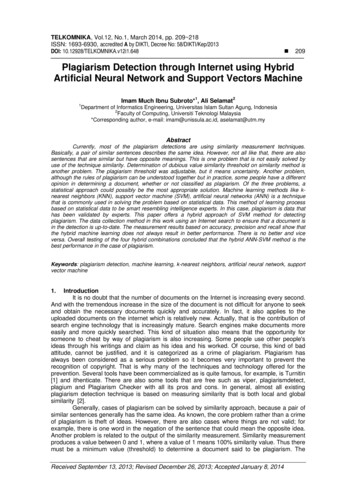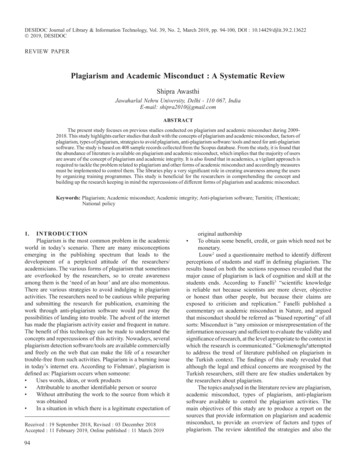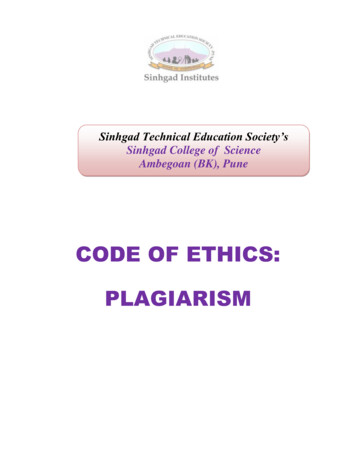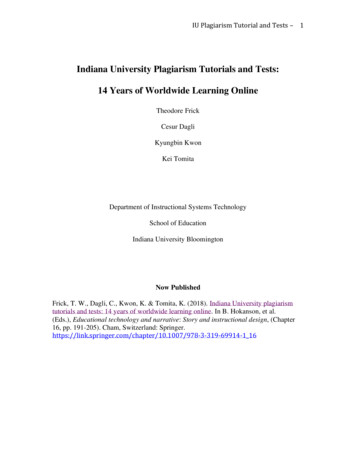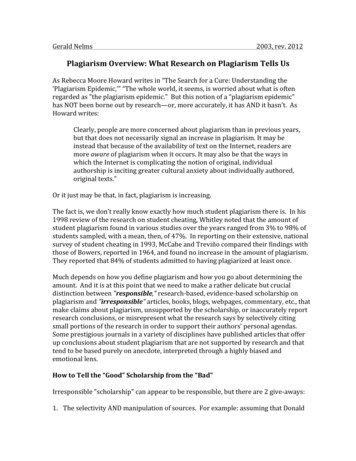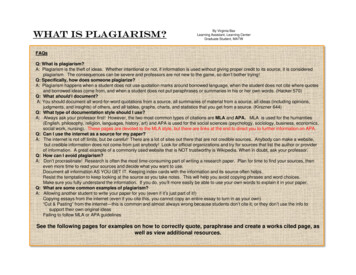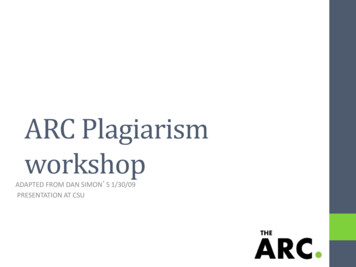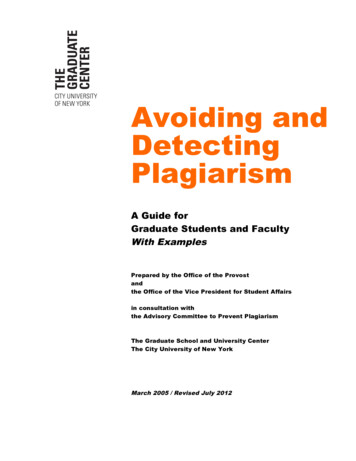
Transcription
Avoiding Plagiarism:How to Practice Academic Integrity"Originality is the essence of true scholarship. Creativity is the soul of the true scholar"- Nnamdi AzikiwePlagiarism is the act of taking another person’s ideas and/or words and claiming them as one’sown, either intentionally or by failing to give credit to the original author. In effect, to plagiarize isto steal from another person. Most, if not all, people recognize the "wrongness" of stealing.Unfortunately, when faced with a hefty assignment, a packed schedule, a dislike (or fear) ofwriting, a misunderstanding of the proper way to cite sources, or any other number of factors,students may commit plagiarism intentionally or accidentally.Thankfully, plagiarism can (and should) be avoided. First, it is important to understand whatplagiarism entails. The brief description above defines plagiarism in a nutshell. Here at BucksCounty Community College, there is a policy in place to help students understand what isexpected of them. This policy can be found in numerous places including on the college's website and in the college catalog. Bucks’ Policy Regarding Plagiarism and Cheating states:The expectation at Bucks County Community College isthat the principles of truth and honesty will be rigorously followed in allacademic endeavors. This assumes that all work will be done by theperson who purports to do the work without unauthorized aids. Inaddition, when making use of language and some idea not his or herown, whether quoting them directly or paraphrasing them into his or herown words, the student must attribute the source of the material in somestandard form, such as naming the source in the text or offering afootnote.Clearly, students should practice academic honesty and integrity in their academics at thisinstitution and beyond. However, students may be intimidated if they do not feel confident intheir abilities to properly paraphrase, quote, and cite secondary sources. It is vitallyimportant that students are proactive about strengthening their knowledge of how toavoid plagiarism, and there are a number of ways to do this. For example, when aninstructor discusses academic integrity in class, students should not hesitate to ask clarifyingquestions and offer their own observations for the benefit of their classmates. In addition,students are always encouraged to come into the Academic Success Center to work ontheir original ideas and proper documentation with a tutor one-on-one.This handout, compiled with permission from Indiana University – Bloomington’s WritingTutorial Services website, is only one of the many resources available to students on thistopic.http://www.indiana.edu/ wts/pamphlets/plagiarism.shtmlBCCC ASC Rev. 5/2017
Plagiarism: What it is and How to Recognize and Avoid ItWhat is Plagiarism and Why is it Important?In college courses, we are continually engaged with other people’s ideas: we read them intexts, hear them in lecture, discuss them in class, and incorporate them into our own writing.As a result, it is very important that we give credit where it is due. Plagiarism is using others’ideas and words without clearly acknowledging the source of that information.How Can Students Avoid Plagiarism?To avoid plagiarism, you must give credit whenever you use Another person’s idea, opinion, or theory;Any facts, statistics, graphs, drawings—any pieces of information—that are not commonknowledge;Quotations of another person’s actual spoken or written words; orParaphrase of another person’s spoken or written words.How to Recognize Unacceptable and Acceptable ParaphrasesHere’s the ORIGINAL text, from page 1 of Lizzie Borden: A Case Book of Family and Crime inthe 1890s by Joyce Williams et al.:The rise of industry, the growth of cities, and the expansion of the population were thethree great developments of late nineteenth century American history. As new, larger,steam-powered factories became a feature of the American landscape in the East, theytransformed farm hands into industrial laborers, and provided jobs for a rising tide ofimmigrants. With industry came urbanization the growth of large cities (like Fall River,Massachusetts, where the Bordens lived) which became the centers of production aswell as of commerce and trade.Here’s an UNACCEPTABLE paraphrase that is plagiarism:The increase of industry, the growth of cities, and the explosion of the population were threelarge factors of nineteenth century America. As steam-driven companies became more visiblein the eastern part of the country, they changed farm hands into factory workers and providedjobs for the large wave of immigrants. With industry came the growth of large cities like FallRiver where the Bordens lived which turned into centers of commerce and trade as well asproduction.What makes this passage plagiarism?The preceding passage is considered plagiarism for two reasons: The writer has only changed around a few words and phrases, or changed the order ofthe original’s sentences.The writer has failed to cite a source for any of the ideas or facts.http://www.indiana.edu/ wts/pamphlets/plagiarism.shtmlBCCC ASC Rev. 5/2017
If you do either or both of these things, you are plagiarizing.NOTE: This paragraph is also problematic because it changes the sense of several sentences(for example, "steam-driven companies" in sentence two misses the original’s emphasis onfactories).Here’s an ACCEPTABLE paraphrase:Fall River, where the Borden family lived, was typical of northeastern industrial cities of thenineteenth century. Steam-powered production had shifted labor from agriculture tomanufacturing, and as immigrants arrived in the US, they found work in these new factories.As a result, populations grew, and large urban areas arose. Fall River was one of thesemanufacturing and commercial centers (Williams 1).Why is this passage acceptable?This is acceptable paraphrasing because the writer: Accurately relays the information in the originalUses her own words.Lets her reader know the source of her information.Here’s an example of quotation and paraphrase used together, which is alsoACCEPTABLE:Fall River, where the Borden family lived, was typical of northeastern industrial cities of thenineteenth century. As steam-powered production shifted labor from agriculture tomanufacturing, the demand for workers "transformed farm hands into industrial laborers," andcreated jobs for immigrants. In turn, growing populations increased the size of urban areas.Fall River was one of these hubs "which became the centers of production as well as ofcommerce and trade" (Williams 1).Why is this passage acceptable?This is acceptable paraphrasing because the writer: Records the information in the original passage accurately.Gives credit for the ideas in this passage.Indicated which part is taken directly from her source by putting the passage in quotationmarks and citing the page number.Note that if the writer had used these phrases or sentences in her own paper without puttingquotation marks around them, she would be PLAGIARIZING. Using another person’s phrasesor sentences without putting quotation marks around them is considered plagiarism EVEN IFTHE WRITER CITES IN HER OWN TEXT THE SOURCE OF THE PHRASES ORSENTENCES SHE HAS QUOTED.http://www.indiana.edu/ wts/pamphlets/plagiarism.shtmlBCCC ASC Rev. 5/2017
Plagiarism and the World Wide WebThe World Wide Web has become a more popular source of information for student papers,and many questions have arisen about how to avoid plagiarizing these sources. In most cases,the same rules apply as to a printed source: when a writer must refer to ideas or quote from aWWW site, she must cite that source.If a writer wants to use visual information from a WWW site, many of the same rules apply.Copying visual information or graphics from a WWW site (or from a printed source) is verysimilar to quoting information, and the source of the visual information or graphic must becited. These rules also apply to other uses of textual or visual information from WWW sites; forexample, if a student is constructing a web page as a class project, and copies graphics orvisual information from other sites, she must also provide information about the source of thisinformation. In this case, it might be a good idea to obtain permission from the WWW site’sowner before using the graphics.Strategies for Avoiding Plagiarism1. Put in quotations everything that comes directly from the text especially when taking notes.2. Paraphrase, but be sure you are not just rearranging or replacing a few words.Instead, read over what you want to paraphrase carefully; cover up the text with your hand, orclose the text so you can’t see any of it (and so aren’t tempted to use the text as a “guide”).Write out the idea in your own words without peeking.3. Check your paraphrase against the original text to be sure you have not accidentally usedthe same phrases or words, and that the information is accurate.Terms You Need to Know (or What is Common Knowledge?)Common knowledge: facts that can be found in numerous places and are likely to be knownby a lot of people.Example: John F. Kennedy was elected President of the United States in 1960.This is generally known information. You do not need to document this fact.However, you must document facts that are not generally known and ideas that interpret facts.Example: According to the American Family Leave Coalition’s new book, Family Issues andCongress, President Bush’s relationship with Congress has hindered family leave legislation(6).The idea that “Bush’s relationship with Congress has hindered family leave legislation” is not afact but an interpretation; consequently, you need to cite your source.http://www.indiana.edu/ wts/pamphlets/plagiarism.shtmlBCCC ASC Rev. 5/2017
Quotation: using someone’s words. When you quote, place the passage you are using inquotation marks, and document the source according to a standard documentation style.The following example uses the Modern Language Association’s style:Example: According to Peter S. Pritchard in USA Today, “Public schools need reform butthey’re irreplaceable in teaching all the nation’s young” (14).Paraphrase: using someone’s ideas, but putting them in your own words. This is probably theskill you will use most when incorporating sources into your writing. Although you use your ownwords to paraphrase, you must still acknowledge the source of the information.Produced by Writing Tutorial Services, Indiana University, Bloomington, INWriting Tutorial ServicesCenter for Innovative Teaching and LearningWells Library Learning Commons, 1320 E. Tenth St., Bloomington, IN 47405Phone: (812) 855-6738Copyright 2011, the Trustees of Indiana Universityhttp://www.indiana.edu/ wts/pamphlets/plagiarism.shtmlBCCC ASC Rev. 5/2017
Plagiarism: What it is and How to Recognize and Avoid It What is Plagiarism and Why is it Important? In college courses, we are conti


